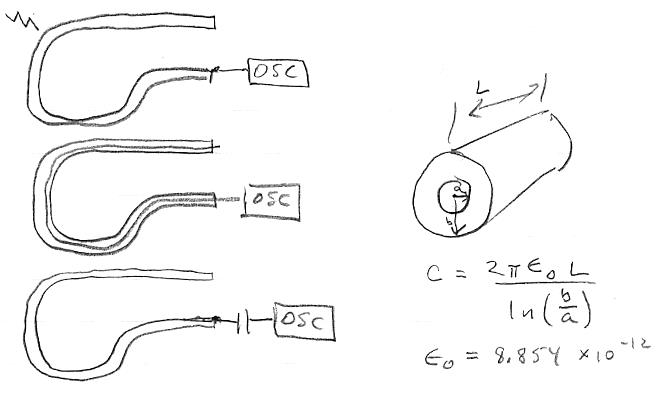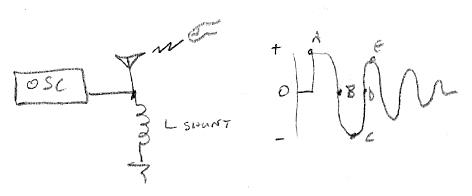Snake In The Tube
The following has been proposed as a method of ameliorating ESD (Electro-Static Discharge) damage to the volume side electronics:
Instead of simply connecting the volume antenna to the electronics (top left), an insulated wire is snaked through the tube (middle left). The wire has an insulating plastic jacket that is rated at some high maximum voltage, say 1kV. At first glance this would seem to strongly imply that we are insulating the volume electronics with 1kV of ESD protection, but that's probably not the case.
The wire in the tube forms a concentric cylindrical capacitor, for which there is a closed form solution (right). Assigning reasonable numbers: length = 1m, wire radius = 1.5mm, tube inner radius = 4mm, which yields a calculated capacitance of 57pF. The exact value isn't all that important, we're just looking for a ball park number to have some idea of what we're dealing with.
So, for theoretical purposes, we can replace the wire with an explicit ~57pF bulk capacitor (bottom left), also with a rating of 1kV. Has anything changed in terms of ESD? To know for sure you would have to test both cases to failure! But lets talk about what ESD does. In the worst case it is an abrupt electrical discharge of hundreds or thousands of volts. The abruptness means it has a lot of high frequency content (events that are small in the time domain are large in the frequency domain, and vice-versa). The conduction through a capacitor is proportional to frequency, so the capacitor could easily look more or less like a dead short for ESD edges.
My feeling is that there probably isn't much difference between the distributed wire capacitor and the explicit bulk capacitor, and a series capacitor probably isn't all that effective at limiting ESD damage in the first place. It might be better than nothing but to know for sure you would have to test both cases to failure!
It's also my feeling that insulating the outer surface of the tube itself is probably more effective at dissipating ESD before it reaches the tube, but to know for sure you would have to test both cases to failure!
You will notice on my D-Lev thread that I make absolutely no mention of how effective (or ineffective) the ESD protection implemented on the AFE is because to know for sure I would have to test to failure and I haven't done that. Making sweeping claims as to the effectiveness of a particular implementation of a particular ESD protection scheme without doing actual testing is foolhardy in the extreme.



